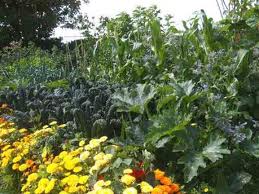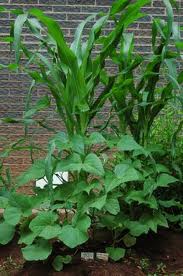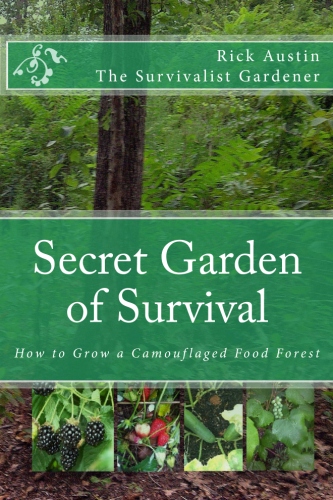Okay, I'll admit it. The thought of gardening … well made me kinda wince. I mean, you want me to deliberately put my manicured nails into that dirt! As if! Right? I know!
Then Rick Autstin told me about natureculture. A long fancy word for letting your garden go all natural. You just let it grow! No weeding (like I'd know the difference between a weed and a plant anyhow), pruning, shoveling or raking - none of the things you'd typically think of to care for a traditional garden.
Well sign me up that's my kinda gardening!
So I began to do a little research on nautreculture. I mean it really sounded a little too good to be true. There just had to be a catch.
This is what I found.
In its simplest form permaculture works like this: 
You’ve heard of people going into the woods to pick wild blueberries or blackberries? Right? Who do you think planted those berries? I mean if no one is in the woods to hear if a tree makes a sound when it falls or to verify that a bear poops in the wood, it must be nature. Has to be. Everything just working together. No not the tree and the bear I mean the plants and berries. No one comes in and fertilizes the woods. The plants and wild growth work together to fertilize one another.
It’s self-sufficient. Kinda like having a beta fish. You plunk a granule or two of fish food in the bowl every so often and voila you have a living pet. Only difference here is we’re taking living food. And you don't use fish food.
Oh, and forget the pretty little perfectly lined rows of a traditional garden or the groups of like-kind veggies. Not with permaculture.
Everything is clumped together - but in a system kinda way. Think Garden of Eden gone wild in your backyard (okay maybe jungle-y). “Ugh! I knew there was a catch” you whine! Well yes and no. Remember you don’t have to tend to the garden?? But then there is this little matter of bugs.
“Ewwww! Bugs! Nope I'm outta here.”
Hold your horses! Hear me out.
There are good bugs and bad bugs. Just like the garden takes care of itself, the bugs do the same thing.
By planting plants and veggies that attract good bugs next to ones that attract bad bugs, the good bugs will eat the bad bugs and eliminate the need for bug spray. See where I'm goin’?! Another thing you won't have to do - spray for bugs! Its call companion planting, cool huh?
Ya see pesticides kill all the bugs, good and bad, which work against nature. By companion planting, the pests are eaten by the predator bugs just like in the forest or in nature. Think about it, you don’t see anyone going around fertilizing the forest do you? And if you did, you might want to ask him about the “tree falling and the bear pooping questions?” I digress.
As for the planting and/or seeding of your garden, I've used the 'one over here, one over there, another one here and so on' method. The reason is that if per chance you have an aggressive pest that say likes squash. If all your squash is planted together the pest can just stay in one area and move from plant to plant and eat to his heart content without moving to another section of your garden. If you have your squash dispersed in different locations it makes it a little more difficult for the pest to eat all of your squash in one sitting (like a squash buffet)? Make em work for it.
And, another benefit to permaculture? You can plant in as little as a 5’x5’ area or acre upon acre. It all depends on you and what and how much you want to grow.
 A neat little trick I use is, I plant my corn then once it reaches about 4 inches I plant pole beans around the corn so they have something to climb on and then squash (cantaloupe or watermelon work well too) around the beans. Its call the ‘three-sisters’ method. So in just a little space you have three things growing together. You might want to try this as a starting point.
A neat little trick I use is, I plant my corn then once it reaches about 4 inches I plant pole beans around the corn so they have something to climb on and then squash (cantaloupe or watermelon work well too) around the beans. Its call the ‘three-sisters’ method. So in just a little space you have three things growing together. You might want to try this as a starting point.
So there you have it permaculture 101 all wrapped up in a tidy little bow.
Oh, I purposely, did not go into the chemically-side of permaculture, but as an example, with the three-sister method, the reason they are planted together is because the beans and squash are nitrogen fixers for the corn that sucks out a lot of nitrogen from the soil.
A great book for survival garden natureculture is a book called "Secret Garden of Survival - How to Grow a Camouflage Food Forest" by Rick Austin. 
Do your own research and you’ll soon be singing my praise for telling you about permaculture, or be on one of the national TV talk shows for finding the man in the forest who told you all the secrets to the universe.
Just sayin.
- Survivor Jane

Thank you for sharing Survivor Jane with your friends!
If you have any questions, or would like to see a specific article addressing survival preparedness for women on SurvivorJane.com click here
Follow me on Twitter @SurvivorJane and use the hashtag #PrepperTalk - "Building the Largest Prepper Community One Social Media at a Time!"

